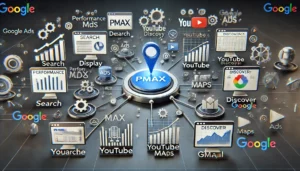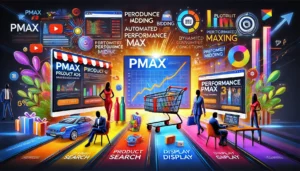PMax Explained: What is Performance Max and How Does It Work?

Performance Max, or PMax, is a new type of campaign in Google Ads that uses machine learning to improve ad performance across all Google platforms. This article will explain what PMax is, how it works, and how businesses can benefit from it.
Key Takeaways
- Performance Max (PMax) uses machine learning to optimise ads across all Google platforms.
- PMax simplifies campaign management by combining multiple ad formats into a single campaign.
- Businesses can benefit from PMax’s automated bidding and real-time optimisation features.
- Setting up a PMax campaign involves choosing objectives, selecting conversion goals, and creating creative assets.
- While PMax offers many benefits, it also has limitations such as limited visibility on placements and potential impact on other campaigns.
Understanding PMax: An Overview
What is PMax?
Performance Max, or PMax, is an automated campaign type in Google Ads. It leverages Google’s machine learning to drive more conversions across all of Google’s platforms. This includes Search, Display, YouTube, Discover, Gmail, and Maps. PMax ads are created automatically from the inputs provided by advertisers, similar to responsive search and display ads. The main goal of PMax is to achieve specified conversion goals at the campaign level.
Key Features of PMax
PMax offers several key features that make it a powerful tool for digital advertising:
- Cross-Platform Reach: PMax is the only campaign type that allows you to reach users across the entire scope of Google’s inventory in one campaign.
- Automated Bidding: Google optimises bids for the right user at the right time with the right message.
- Simplified Campaign Management: PMax provides unified reporting across all platforms, reducing the amount of manual work.
- Advanced Creative Capabilities: Google automatically tests different ad formats and combinations to reach peak effectiveness.
- Adaptiveness: PMax’s machine learning capabilities allow it to quickly adapt to sudden user behaviour changes, market trends, or seasonality.
Why PMax Matters in Digital Advertising
PMax is a game-changer in digital advertising for several reasons. Firstly, it offers a cross-platform reach that no other campaign type can match. This opens up additional audiences that you may not have reached with singular campaign types. Secondly, the automated bidding and budget optimisation features mean that Google does the heavy lifting, allowing us to focus on strategy and creative inputs. Lastly, the simplified campaign management and advanced creative capabilities make it easier to manage and optimise campaigns effectively.
PMax relies heavily on conversion history data, so if conversion volume is sparse, performance may be hindered. It’s recommended to spend at least £40-£80 per day for 30 days to determine results.
How PMax Utilises Machine Learning
The Role of AI in PMax
In Performance Max (PMax), artificial intelligence (AI) plays a crucial role. It helps in analysing vast amounts of data to make real-time decisions. This means our campaigns can adapt quickly to changes in user behaviour and market trends. AI ensures that our ads are shown to the right people at the right time.
Smart Bidding Strategies
PMax uses smart bidding strategies to optimise our ad spend. By leveraging machine learning, it adjusts bids based on the likelihood of a conversion. This not only maximises our return on investment but also helps in achieving our specific campaign goals. We can set targets like cost per action (CPA) or return on ad spend (ROAS) to guide the AI.
Real-Time Optimisation
One of the standout features of PMax is its ability to optimise in real-time. The system continuously monitors performance and makes adjustments on the fly. This ensures that our campaigns are always performing at their best. Real-time optimisation is particularly beneficial for adapting to sudden changes in the market or user behaviour.
With PMax, we can trust that our campaigns are being managed efficiently, allowing us to focus on other important aspects of our business.
Setting Up Your First PMax Campaign
Choosing Campaign Objectives
When setting up your first PMax campaign, the initial step is to choose your campaign objectives. This is crucial as it guides the entire campaign setup. We need to decide whether we aim for conversions, sales, or leads. Selecting the right objective ensures that the campaign aligns with our business goals.
Selecting Conversion Goals
Next, we move on to selecting conversion goals. This step is vital for optimising the campaign. We should focus on the most important actions we want users to take, such as purchases or sign-ups. It’s essential to remove any non-essential goals to avoid tracking irrelevant actions.
Generating Creative Assets
Finally, we need to generate creative assets. These include images, videos, and text that will be used in our ads. The quality of these assets can significantly impact the campaign’s performance. We should ensure that our creative assets are engaging and relevant to our target audience.
Remember, the success of a PMax campaign heavily relies on the quality of inputs we provide. From choosing the right objectives to creating compelling assets, every step matters.
By following these steps, we can set up a PMax campaign that is well-aligned with our business goals and poised for success.
Benefits of Using PMax for Your Business
Cross-Platform Reach
One of the standout benefits of PMax is its ability to reach users across multiple platforms. This is the only campaign type that allows us to target users on Google Search, Display, YouTube, Discover, Gmail, and Maps all within a single campaign. This broad reach opens up additional audiences that we might not have reached with other campaign types.
Automated Bidding
PMax takes the heavy lifting out of bid management. Google’s machine learning algorithms optimise bids in real-time, ensuring that our ads are shown to the right user at the right time with the right message. This not only saves us time but also helps in maximising our return on investment.
Simplified Campaign Management
Managing campaigns can be a daunting task, but PMax simplifies this process. With unified reporting across all platforms, we can easily track performance and make informed decisions. The reduced manual work, like bid adjustments, makes it easier for us to focus on strategy rather than execution.
PMax is a game-changer for businesses looking to streamline their digital advertising efforts.
Advanced Creative Capabilities
PMax allows us to leverage a variety of ad formats, as ads can be placed across all of Google’s inventory. Google automatically tests different formats and combinations to find the most effective ones. This means we can focus on creating compelling content while Google handles the optimisation.
Adaptiveness
At the heart of PMax is its machine learning capabilities. The algorithms quickly adapt to sudden user behaviour changes, market trends, or seasonality. This ensures that our campaigns remain effective even in a rapidly changing environment.
Challenges and Limitations of PMax
Limited Visibility on Placements
One of the main challenges with PMax is the limited visibility on where your ads are shown. While PMax campaigns can display ads across a wide range of Google properties, the reporting on these placements is often vague. We can see the number of impressions, but detailed information about specific sites is lacking. This can make it difficult to understand where your ads are performing best.
Impact on Other Campaigns
PMax can also affect the performance of other campaigns in your account. For instance, if you have both a PMax campaign and a keyword-based search campaign targeting the same audience, the PMax campaign might take precedence. This can lead to PMax taking credit for conversions that would have occurred through your other campaigns, potentially skewing your performance data.
Cannibalisation Concerns
Another issue is the potential for cannibalisation. Since PMax campaigns can overlap with other types of campaigns, there’s a risk that they might compete against each other. This can result in higher costs and reduced efficiency. To mitigate this, it’s crucial to carefully manage and monitor your campaigns to ensure they complement rather than compete with each other.
While PMax offers many benefits, it’s essential to be aware of these challenges to make the most of your digital advertising efforts.
Best Practises for Optimising PMax Campaigns
Accurate Conversion Tracking
To get the most out of PMax, we need to ensure our conversion tracking is spot on. PMax relies heavily on conversion data to optimise and target effectively. Make sure all conversion points are tracking accurately. Import any offline conversion data if applicable. Accurate tracking is crucial for success.
Effective Budget Management
Managing your budget effectively is key. PMax campaigns need a flexible budget to perform well. If the budget is too tight, the campaign might not reach its full potential. We recommend spending at least £40-£80 per day for 30 days to see meaningful results. This allows the campaign to gather enough data for optimisation.
Utilising Audience Signals
Audience signals are vital for PMax. High-intent audience signals, such as first-party customer data or website visitors, help Google learn who your best customers are. Adding broad audience signals like affinity segments won’t be enough. Focus on specific, high-intent signals to drive better performance.
Remember, PMax campaigns thrive on data. The more accurate and detailed your inputs, the better the machine learning algorithms can optimise your campaigns.
By following these best practises, we can maximise the effectiveness of our PMax campaigns and achieve better results for our business.
Comparing PMax with Other Campaign Types
PMax vs Standard Shopping
When we compare Performance Max (PMax) with Standard Shopping campaigns, the differences are quite clear. PMax offers a wider reach by displaying ads across various Google platforms like Search, Display, YouTube, and Gmail. In contrast, Standard Shopping is limited to the Search Network and its partners.
| Feature | Performance Max | Standard Shopping |
|---|---|---|
| Placements | Search, Display, YouTube, Gmail, Discovery, Maps | Search Network (with partners) |
| Reach | Very wide | Limited |
| Bid Strategy | Maximise Conversions or Conversion Value | Manual CPC, Maximise Clicks, Target ROAS |
| Control | Low | Very high |
| Conversion Volume Requirements | Yes | No |
| Campaign Transparency | Medium | High |
| Optimisation Potential | Medium | Very high |
| Dynamic Remarketing | Yes | No |
| Impact on Search Campaigns | Yes | None |
PMax is more automated, relying heavily on machine learning to optimise bids and placements. Standard Shopping, however, gives us more control over bids and targeting, making it suitable for those who prefer a hands-on approach.
PMax vs Search Campaigns
Search campaigns primarily use keyword targeting, which allows us to reach users actively searching for specific terms. PMax, on the other hand, uses machine learning and audience signals to optimise targeting. This means PMax can adapt quickly to changes in user behaviour and market trends.
Search campaigns offer more transparency and control, letting us see exactly which keywords are driving traffic and conversions. However, PMax simplifies campaign management by automating many of these tasks, freeing up time for other strategic activities.
PMax vs Display Campaigns
Display campaigns focus on reaching users based on their interests and behaviours, primarily through visual ads. PMax combines this approach with other formats like text and video ads, providing a more comprehensive advertising solution.
While Display campaigns allow for detailed targeting and creative control, PMax leverages machine learning to optimise across multiple platforms and ad formats. This makes PMax a versatile option for those looking to maximise their advertising reach and efficiency.
In summary, each campaign type has its unique strengths and is driven by different marketing objectives. PMax stands out for its automation and cross-platform reach, but other campaign types offer more control and transparency.
Industries That Benefit Most from PMax
Ecommerce
Ecommerce businesses are prime candidates for Performance Max (PMax) campaigns. With the ability to integrate product feeds, PMax can dynamically create ads that showcase products to potential customers. This is especially useful for brands with a short sales cycle, as it helps drive quick conversions. Automated bidding and cross-platform reach ensure that your products are seen by the right audience at the right time.
Lead Generation
For companies focused on lead generation, PMax offers a streamlined way to capture potential clients. By leveraging Google’s machine learning, PMax can identify high-intent audience signals and optimise ad placements. This is particularly beneficial for businesses that need to generate leads quickly and efficiently. However, it’s important to note that PMax relies heavily on conversion data, so having accurate tracking is crucial.
Local Businesses
Local businesses can also reap significant benefits from PMax campaigns. The platform’s ability to target specific geographic areas ensures that ads are shown to users who are most likely to visit a physical location. This is ideal for businesses like restaurants, retail stores, and service providers. The automated nature of PMax means that even businesses with limited marketing resources can achieve effective results.
PMax campaigns offer a versatile solution for various industries, making it easier to reach and engage with your target audience. Whether you’re in ecommerce, lead generation, or a local business, PMax can help you achieve your marketing goals efficiently.
Case Studies: Success Stories with PMax
Retail Sector
In the retail sector, we’ve seen remarkable results with PMax campaigns. For instance, a well-known fashion retailer used PMax to target specific product categories. They focused on their best-selling items and new arrivals. This strategy led to a 30% increase in conversions within the first month. The ability to concentrate the budget on high-performing products was a game-changer.
Healthcare Industry
The healthcare industry has also benefited from PMax. A leading provider of medical supplies utilised PMax to reach a broader audience. By targeting both healthcare professionals and individual consumers, they saw a significant boost in engagement. Their campaign resulted in a 25% increase in website traffic and a 15% rise in sales. The automated bidding feature played a crucial role in achieving these results.
Service-Based Businesses
Service-based businesses are not left out. A popular home cleaning service adopted PMax to streamline their advertising efforts. They aimed to attract new customers while retaining existing ones. The campaign’s success was evident with a 20% increase in bookings and a noticeable improvement in customer retention. The real-time optimisation feature ensured that their ads were always relevant and effective.
PMax campaigns have proven to be highly effective across various industries, demonstrating their versatility and impact on business growth.
Future Trends in Performance Max and Digital Advertising
Advancements in AI
Artificial Intelligence (AI) is evolving rapidly, and its role in PMax campaigns is set to grow even more. We can expect AI to become smarter at predicting user behaviour and optimising ad placements. This means better performance and higher conversion rates for businesses. AI will also help in creating more personalised ads, making them more relevant to the target audience.
Integration with Other Platforms
PMax is likely to integrate more seamlessly with other digital platforms. This will allow for a more unified approach to digital advertising. Imagine running a campaign that not only targets Google Ads but also extends to social media platforms and other digital channels. This cross-platform reach will be a game-changer for ecommerce PPC and other industries.
Predicted Changes in User Behaviour
User behaviour is always changing, and PMax will need to adapt to these shifts. With the rise of mobile usage and voice search, PMax campaigns will likely focus more on these areas. We might also see more emphasis on video content, given its growing popularity. Keeping an eye on these trends will be crucial for any PPC ad agency looking to stay ahead of the curve.
As we move forward, staying updated with these trends will be essential for maximising the effectiveness of PMax campaigns. The future is bright, and the possibilities are endless.
In summary, the future of PMax and digital advertising is exciting. With advancements in AI, better integration with other platforms, and adapting to changes in user behaviour, PMax will continue to be a powerful tool for businesses. Whether you’re working with Google ads agencies or managing your own campaigns, staying ahead of these trends will be key to success.
The future of PMax and digital advertising is bright and full of potential. As technology advances, new trends are emerging that can help businesses reach their goals more effectively. To stay ahead of the curve, it’s important to keep up with these changes. Visit our website to learn more about how we can help you navigate the ever-evolving world of digital advertising.
Conclusion
Performance Max is a powerful tool in the Google Ads arsenal, offering a streamlined way to reach potential customers across multiple platforms. By leveraging Google’s machine learning, it optimises bids and placements to drive more conversions. However, it’s essential to monitor and adjust your campaigns to ensure they align with your business goals. Whether you’re an eCommerce brand looking to boost sales or a business aiming to increase leads, Performance Max can be a valuable addition to your marketing strategy. Remember, the key to success lies in understanding your audience and providing the right inputs for the AI to work effectively.
Frequently Asked Questions
What is Performance Max (PMax)?
Performance Max, or PMax, is an automated campaign type in Google Ads that uses machine learning to optimise ads across all of Google’s channels, like Search, Display, YouTube, and more.
How does PMax use AI?
PMax leverages artificial intelligence to analyse data and optimise bids and placements in real time, aiming to maximise conversions.
What are the main benefits of using Performance Max?
The main benefits of PMax include cross-platform reach, automated bidding, simplified campaign management, and advanced creative capabilities.
How do I set up my first PMax campaign?
To set up your first PMax campaign, you need to choose your campaign objectives, select conversion goals, and generate creative assets.
Can PMax impact my other campaigns?
Yes, PMax can impact other campaigns, especially branded search campaigns, by potentially taking credit for conversions that would have occurred anyway.
What industries benefit most from Performance Max?
Industries like ecommerce, lead generation, and local businesses tend to benefit the most from using PMax due to its automated and data-driven approach.
Are there any limitations to using PMax?
Some limitations of PMax include limited visibility on ad placements, potential impact on other campaigns, and concerns about cannibalisation of existing traffic.
What are some best practises for optimising Performance Max campaigns?
Best practises include accurate conversion tracking, effective budget management, and utilising audience signals to improve campaign performance.
Author
Search Blog
Free PPC Audit
Subscribe to our Newsletter
The Voices of Our Success: Your Words, Our Pride
Don't just take our word for it. With over 100+ five-star reviews, we let our work-and our satisfied clients-speak for us.
"We have been working with PPC Geeks for around 6 months and have found Mark and the team to be very impressive. Having worked with a few companies in this and similar sectors, I rate PPC Geeks as the strongest I have come across. They have taken time to understand our business, our market and competitors and supported us to devise a strategy to generate business. I value the expertise Mark and his team provide and trust them to make the best recommendations for the long-term."
~ Just Go, Alasdair Anderson




